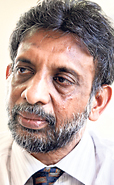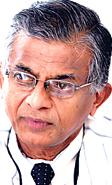None could pass the Beruwela bay without covering his nose, for the stench was unbearable. Boats would bring in their catch each day, the fisherfolk would then chop up the parts of the fish that could be sold and leave the rest behind for a contractor hired by the Urban Council to dispose of the stuff.
However, it did not happen that way – invariably the inedible fish parts would be dumped around the bay, heaps of rotting fish-heads, gills and intestines, not only polluting the area but also sending out a foul smell.
Not any more. Now part of the fish offal is being turned into semi-solid animal feed called fish silage for poultry and pigs for distribution locally. The silage is also converted into a value-added solid poultry and fresh-water fish meal by mixing with rice bran for local use and export.
This is just one instance where the expertise of the Industrial Technology Institute (ITI) has been utilized for the national good of Sri Lanka.
The instances are many as ITI Director Dr. Azeez M. Mubarak lists them, the most recent being the ITI having the capability to test milk and milk products for melamine contamination in the light of the scandal tainting Chinese milk.
Some of the other areas in which the ITI provided a silent service, with many people being unaware of its role, was when there were suspicions about the Mysoor dhal being imported from Australia.
“ITI developed a method to differentiate between Mysoor dhal and horse feed or Vetch, though both look the same,” says Dr. Mubarak touching on his institution’s contribution towards safeguarding the interests of the people.
Animal feed and dhal….is food the only area to which the expertise of ITI can be directed?
“No,” stresses ITI’s Deputy Director Dr. K.P.A. Senaratne, explaining that be it food, environment, herbal or material technology, the ITI has the expertise to handle them all. “Although the Sri Lanka Standards Institution has the capacity to handle some of these areas, ITI is unique in that we have the personnel and the expertise to tackle almost all areas.”
Begun as the Ceylon Institute of Scientific and Industrial Research (CISIR) in 1955, this semi-government institution located at 363, Bauddhaloka Mawatha, had a recent name-change to ITI. It is the premier industrial research institute in the country working through eight units, half for testing and the other half for research, with about 365 staff members including 200 technical officers.
Referring to the “testing units”, Dr. Senaratne says it is a service the ITI offers not only to the government but also to the public.
These services are carried out through four main laboratories:
- Chemical and Microbiology Laboratory which tests water, food, cosmetics, oils etc.
- Materials Laboratory for testing the quality of rubber, plastics, concrete, metal etc.
- Metrology Laboratory to calibrate instruments such as weighing machines, balances, thermometers, tape measures etc to bring them in line with global standards
- Electro-technology Laboratory which has the capability of analyzing sound measurements including noise pollution or vibrations and trouble-shooting sophisticated electronic equipment.
“We are the only accredited Metrology Laboratory in the country and currently we have undertaken to do the tools of the Colombo Dockyard which engages in ship repairs. These tools have to be accredited to ensure that they comply with world standards,” says Dr. Senaratne.
Regarding the Electro-technology Lab, he explains that it is unique to ITI, citing the example of someone who thinks there is too much noise in his neighbourhood. “That person can lodge a complaint with the Central Environmental Authority which would then request us to check the noise levels in that area.”
The examples of ITI’s vital input are numerous – if someone wants to make a herbal cream, the institute would do the relevant research, develop the product and transfer the technology to the client who would then be able to manufacture the product, it is learnt.
 |
 |
| Dr. Mubarak |
Dr. Senaratne |
Through food technology, we have developed a “drying” procedure for ginger, jak fruit etc., he says, adding that ITI has also produced a natural wood preservative for the Cashew Corporation.
Another project in the pipeline is the production of a low-cost ceramic tile by reducing the quantum of energy being used, he said, while plans are underway to carry out sound mapping in Colombo to identify areas of maximum, minimum and average sound prevalence. “Such a map would be important when establishing schools and hospitals.”
ITI also conducts training programmes for the public, explained Dr. Senaratne adding that recently it held a two-day workshop on how to produce rice-based supplementary foods.
The recognition for ITI as a force to be reckoned with comes from the fact that as an accredited institute maintaining quality standards, its expertise is also sought by people from abroad. Recently, IT staff trained a team of scientists from Pakistan and Bangladesh.
For it is ITI which tests tea exports for pesticide residue and assures foreign markets about the quality of Sri Lanka’s major foreign-exchange earner.
Showing the way
- Development of a Rain Gauge to obtain rainfall data, which in turn would help predict floods and also map areas which could be prone to natural disasters like landslides. The rain gauges installed in Kalutara, Kegalle, Ratnapura, Kandy and Kahawatte are transmitting data automatically through the Global Positioning System. “Usually, in the early days this had to be done manually and there could be incorrect readings,” says Dr. Senaratne.
- The complaints are many – commuters alight with splitting headaches or a muffled sound in their ears after being exposed to music blasting from speakers inside buses. Is there noise pollution? This is what ITI staff armed with sound monitoring equipment who boarded buses plying between Colombo and Anuradhapura and Colombo and Kandy ascertained on their own volition.
- Bread-making is to be revolutionized with the utilization of 25% of rice flour along with wheat flour. Tests are also being conducted to mix jak when making bread.
|



